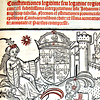

The Corpus Iuris Civilis—the great codification of Roman law—was compiled under the direction of the Emperor Justinian and issued between 529 and 534. Four "books" comprise the Corpus Iuris Civilis: the Code–the laws; the Digest–writings of legal scholars; Institutes–a student textbook; and the Novels (or Novellae)–new laws passed after 534.
The Corpus Iuris Civilis survived the fall of the Roman Empire. Although forgotten for several centuries, it was discovered in Northern Italy in the eleventh century and became the subject of study in universities throughout Europe. The center of scholarship was Bologna, where scholars interpreted and annotated the manuscripts from Justinian's time with "glosses." The most famous glossator was Accursius, whose compilation of the Great Gloss (1220-50) was largely responsible for the renovation of Roman law.
The title page of the Law Library's copy of the Novellae is handwritten: "Volumen de Tortis." The printer, Baptista de Tortis, explains in the preface that this book is called "volume" because it includes many texts all "rolled up" into one: the Novellae; books 10 to 12 of the Code; and two books on feudal law. Surrounding the original text is the gloss of Accursius.
The Law Library's copy retains portions of its original clasps. It is printed in red and black with blue and red initials. The volume's colophon is pictured.
Corpus Iuris Civilis
Volumen de tortis [Novellae constitutiones]
Venice: Baptista de Tortis, 8 January, 1498
Volumen de tortis [Novellae constitutiones]
Venice: Baptista de Tortis, 8 January, 1498


![Abridgement of cases to the end of Henry VI [1460]](/_ui/img/treasures/img/thumbs/Picture2.png)




















